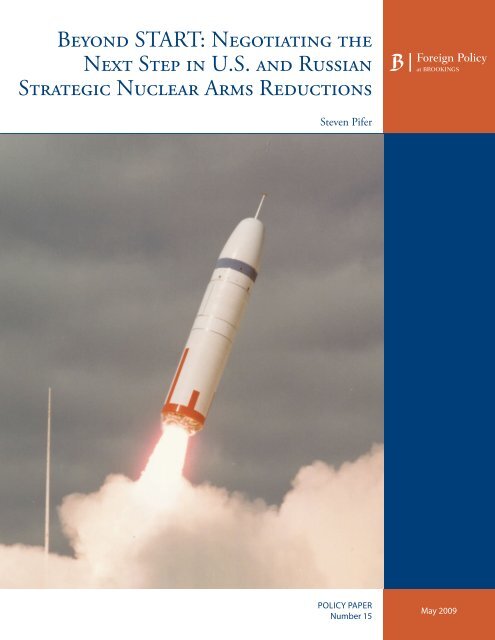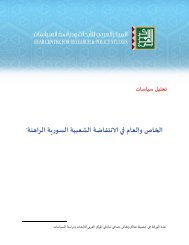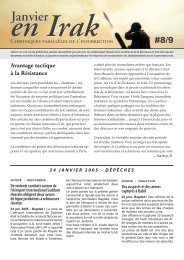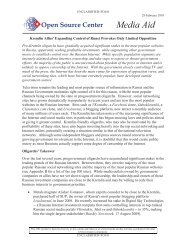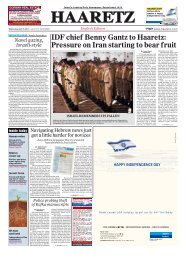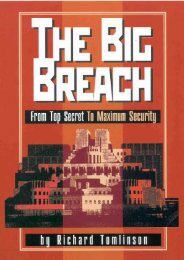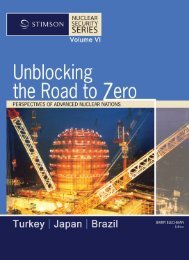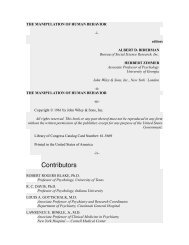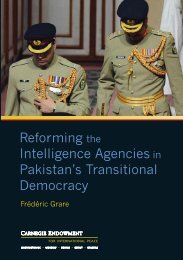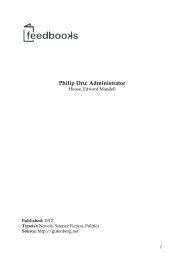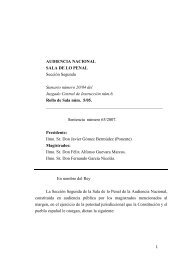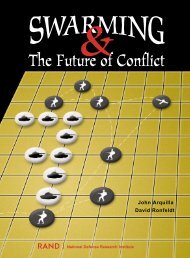Beyond START - Brookings Institution
Beyond START - Brookings Institution
Beyond START - Brookings Institution
Create successful ePaper yourself
Turn your PDF publications into a flip-book with our unique Google optimized e-Paper software.
<strong>Beyond</strong> <strong>START</strong>: Negotiating theNext Step in U.S. and RussianStrategic Nuclear Arms ReductionsForeign Policyat BROOKINGSSteven PiferPOLICY PAPERNumber 15May 2009
Foreign Policyat BROOKINGSPOLICY PAPERNumber 15May 2009<strong>Beyond</strong> <strong>START</strong>: Negotiatingthe Next Step in U.S. and RussianStrategic Nuclear Arms ReductionsSteven Pifer
Ta b l e of C o n t e n t sAcknowledgments . . . . . . . . . . . . . . . . . . . . . . . . . . . . . . . . . . . . . . . . . . . . . . . . . . . . . . . . . . vIntroduction and Summar y . . . . . . . . . . . . . . . . . . . . . . . . . . . . . . . . . . . . . . . . . . . . . . . . . . . 1Strategic Arms and Strategic Arms Control . . . . . . . . . . . . . . . . . . . . . . . . . . . . . . . . . . . . . 5Considerations for a Follow-on Treaty . . . . . . . . . . . . . . . . . . . . . . . . . . . . . . . . . . . . . . . . . 9Elements of a U.S. Proposal . . . . . . . . . . . . . . . . . . . . . . . . . . . . . . . . . . . . . . . . . . . . . . . . . 17Endnotes . . . . . . . . . . . . . . . . . . . . . . . . . . . . . . . . . . . . . . . . . . . . . . . . . . . . . . . . . . . . . . . . 21About the Author . . . . . . . . . . . . . . . . . . . . . . . . . . . . . . . . . . . . . . . . . . . . . . . . . . . . . . . . . 23Fo r e i g n P o l i c y at Bro o k i n g siii
A c k n o w l e d g m e n t sam extremely grateful to Linton Brooks, Ivo Daalder, Robert Einhorn, Edward Ifft, Michael O’Hanlon,I Theodore Piccone, Pavel Podvig, Sergey Rogov, Strobe Talbott, and Alexander Vershbow for taking the timeto review drafts of this policy paper and for the very helpful comments and suggestions that they provided. Ofcourse, the views and recommendations contained here are my own.I would also like to express my appreciation to Gail Chalef and Ian Livingston for their assistance in the paper’sproduction. Finally, I appreciate the support of the <strong>Brookings</strong> Center on the United States and Europe.Fo r e i g n P o l i c y at Bro o k i n g sv
I n t r o d u c t i o n and Summar yMoving <strong>Beyond</strong> <strong>START</strong>Meeting in London on April 1, U.S. President BarackObama and Russian President Dmitry Medvedevannounced agreement to “work out a new, comprehensive,legally binding agreement on reducing andlimiting strategic offensive arms.” They stated theirintention to conclude this agreement before the StrategicArms Reductions Treaty (<strong>START</strong>) expires inDecember, and noted that the new treaty would “recordlevels of reductions in strategic offensive armsthat will be lower than those in the 2002 MoscowTreaty on Strategic Offensive Reductions.” 1The presidents instructed their negotiators to beginwork immediately and report back by July, whenPresident Obama will visit Moscow. U.S. and Russiannegotiators held their first consultative meetingin Rome on April 24, and stated that they will holdtheir first round of full negotiations in mid-May.Presidents Obama and Medvedev agreed to concludea follow-on treaty to <strong>START</strong> as the first action in astep-by-step process of reducing their strategic nucleararsenals with the ultimate goal of achieving a nuclear-freeworld. This ambitious objective will requirebroadening past U.S.-Russian nuclear arms controlefforts, for example, to include non-deployed strategicnuclear warheads and tactical nuclear weapons,which have not been limited previously. This will bea long-term process.In the immediate term, maintaining a strategic nucleararms control framework beyond <strong>START</strong> and concludinga new agreement on strategic reductions canenhance U.S. security by promoting nuclear stability,strengthening predictability, and setting the stage forfurther reductions. It will restore U.S. credibility andleadership in the area of nuclear non-proliferation.A robust nuclear arms control dialogue historicallyhas had a positive impact on the broader relationshipbetween Washington and Moscow.Replacing <strong>START</strong> is urgent. <strong>START</strong> limits each sideto 1600 strategic nuclear delivery vehicles (SNDVs)—heavy bombers, deployed intercontinental ballisticmissiles (ICBMs) and their associated launchers,and deployed submarine-launched ballistic missiles(SLBMs) and their associated launchers—and to6000 strategic nuclear warheads on those systems. 2It expires by its terms on December 5, 2009. The2002 Strategic Offensive Reductions Treaty (SORT),which limits each side to 1700-2200 strategic nuclearwarheads, will remain in effect until 2012, but<strong>START</strong> provides the principal framework for verifiablyregulating U.S. and Russian strategic forces.SORT does not limit strategic bombers or ballisticmissiles, has no counting rules, and contains no verificationor monitoring measures.Negotiating ConsiderationsWashington will have to weigh a number of considerationsin developing a position for negotiationswith the Russians on a <strong>START</strong> follow-on treaty toreduce and limit both strategic nuclear warheads andSNDVs:• Levels of Weapons and the Nuclear Posture Review:The U.S. government must complete its nuclearposture review in order to be able to justify its proposedweapon levels and force structure. While theFo r e i g n P o l i c y at Bro o k i n g s 1
United States and Russia might be able to agree ona reduction to 1000 deployed strategic warheadson each side in the not-too-distant future, doing sowill not be possible this year. They should insteadnegotiate a treaty in 2009 that reduces each side’sforces to no more than 1500 deployed strategicnuclear warheads on 700 SNDVs.• Time: The negotiators have limited time, as <strong>START</strong>expires on December 5. In order to allow for Senateratification, the follow-on treaty likely must besigned by September. Washington and Moscowshould be prepared to consider some bridging arrangementshould they require additional time tofinalize and ratify the follow-on treaty.• Counting Rules: A priority task will be determiningthe counting rules for the new agreement. Indeveloping the follow-on treaty, the negotiatorsshould adopt <strong>START</strong>-type counting rules that attributea specific number of warheads to each typeof strategic ballistic missile and bomber. This willfacilitate counting and verification.• Downloading: For purposes of nuclear stability,neither side will want to concentrate its warheadson too few missile launchers or submarines.The follow-on treaty should include downloadingprovisions to allow the sides to remove warheadsfrom ballistic missiles, as <strong>START</strong> permitsto a limited extent, and also to allow removal ofsubmarine-launched ballistic missiles from missilecarryingsubmarines. Downloaded missiles wouldbe counted with fewer warheads and downloadedsubmarines with fewer missiles than they are otherwisecapable of carrying.• Conversion and Conventionally-Armed Systems: Thefollow-on treaty should contain provisions thatallow the sides to convert some strategic systemsto conventional-only roles and remove them frombeing accountable under the treaty. A potentiallydifficult issue will be conventional warheads ontreaty-accountable ballistic missiles.• Constraining Breakout Potential: The follow-ontreaty will need inspection measures and otherprocedures to prevent the rapid uploading ofdownloaded systems. This can be addressed byprovisions for inspections of downloaded systems,for preventing rapid uploading, and forverifiably eliminating excess ballistic missiles andwarheads.• Monitoring and Verification Measures: The sidesshould consider streamlining <strong>START</strong>’s verificationmeasures. However, the follow-on treatywill need sufficient monitoring measures to givethe sides confidence in their ability to verify theother’s compliance. In order to complete the treatyquickly, the sides should avoid new verificationprovisions where possible, though more intrusivemeasures will be needed in subsequent agreementsthat provide for deeper reductions.• Third-Country Strategic Forces: As U.S. and Russianstrategic force levels decrease, the strategic forcesof Britain, France, and China will assume greaterimportance. The United States and Russia shouldbe able to reduce their deployed strategic warheadsto 1500, or even 1000, without taking accountof third-country forces. However, at some pointthereafter those forces will have to be addressed,either through separate constraints or by multilateralizingthe U.S.-Russian strategic nuclear reductionsprocess.• Missile Defense: As U.S. and Russian strategic forcesare reduced, there will be greater pressure to addressmissile defense. This will have to be factoredin at some point, but the sides should be able tocut their forces to 1500, and perhaps 1000, deployedwarheads without limits on missile defensesystems. Bringing constraints on missile defenseinto the negotiation of the <strong>START</strong> follow-on treatywould likely make it impossible to have a treatyconcluded and ratified by December.• Tactical Nuclear Weapons: As U.S. and Russianstrategic nuclear forces are reduced, their tacticalnuclear weapons will assume greater importance.They can be left aside for the immediate negotiation,but will have to be addressed at some futurepoint as further strategic reductions are considered.2 B e y o n d <strong>START</strong>: Negotiating the Nex t Step in U.S. and Russian Strategic Nuclear Arms Reduc t i o n s
A U.S. Negotiating PositionGiven the shortness of time until <strong>START</strong>’s expirationin December, the Obama administration should seeka <strong>START</strong> follow-on treaty that sets a ceiling of 1500deployed strategic warheads on 700 SNDVs on eachside. As a subsequent step, perhaps in 2010, the UnitedStates and Russia could pursue deeper reductions.When negotiating the follow-on treaty, the administrationshould draw heavily on <strong>START</strong> for countingrules and verification measures; seek to include provisionsfor downloading missiles and missile-carryingsubmarines, with appropriate verification measuresand constraints on breakout potential; and allow someconversion of strategic systems to conventional-onlyroles. While third-country strategic nuclear forces,missile defense, and tactical nuclear weapons willneed to be taken into account at some point in thestrategic reductions process, U.S. negotiators shouldseek to leave them aside for the immediate negotiationof the <strong>START</strong> follow-on treaty or address themin other channels.A limit of 1500 deployed warheads on 700 SNDVswould allow the United States and Russia to maintainsurvivable and effective strategic nuclear forces,though at levels significantly below those today. Undersuch an agreement, the United States could deploya force structure with 300 single-warhead MinutemanIII ICBMs, 168 Trident II SLBMs (with fivewarheads each), and some 50 nuclear-capable heavybombers.This is largely a modified <strong>START</strong> framework. PresidentObama has called for reductions in “all U.S. andRussian nuclear weapons—whether deployed or nondeployed,whether strategic or nonstrategic.” If he andPresident Medvedev are serious about pursuing evendeeper reductions, the <strong>START</strong> framework will have tobe broadened. Washington and Moscow will have todevelop new approaches that bring non-deployed strategicnuclear warheads and tactical nuclear warheadsinto the arms reduction process. Washington shouldtake or propose several measures in parallel with thenegotiation of a <strong>START</strong> follow-on treaty:• Comprehensive Test Ban Treaty: The U.S. administrationshould seek Senate ratification of the treaty,which the Russians previously ratified.• A Broad Nuclear Security Approach: With a view tothe 2010 Non-Proliferation Treaty (NPT) reviewconference, Washington should suggest to Moscowthat they lead in a broad effort that wouldgo beyond negotiation of the follow-on treaty toinclude: support for measures to prevent furthernuclear proliferation; a joint effort to provideenrichment services for civil nuclear reactors innon-nuclear weapons states; and leadership inpromoting a fissile materials cut-off treaty.• Missile Defense: While not bringing missile defenseinto the <strong>START</strong> follow-on negotiations, Washingtonand Moscow should discuss the relationshipbetween offensive and defensive arms, differencesover the U.S. plan to deploy a missile defensesystem in Central Europe, and possible joint approaches,including NATO-Russia cooperation, toaddress the challenge posed by new ballistic missilethreats.• Warhead Numbers: While counting rules can givea good tally of deployed strategic warheads, neitherside knows with confidence the other’s numberof non-deployed warheads. At a level of 1500deployed strategic warheads, this will not mattermuch. However, in anticipation of deeper reductions,Washington should propose to Moscowdiscussions on how the sides might better understandeach other’s strategic warhead numbers,non-deployed as well as deployed warheads. Aprocess of continuing reductions will ultimatelyrequire a framework that addresses all strategicwarheads.• Tactical Nuclear Weapons: Washington should proposediscussions on measures to increase transparencyregarding tactical nuclear weapons and possibleapproaches for dealing with them in the future.Those discussions might also address measures toassure that tactical nuclear weapons on both sidesare safely and securely stored.Fo r e i g n P o l i c y at Bro o k i n g s 3
S t r a tegic Arms and Strategic Arms Co n t ro lNuclear DeterrenceThe primary purpose of U.S. nuclear weapons hasbeen deterrence, that is, to make clear to a potentialadversary that the risks and costs of aggression faroutweigh any gains it might hope to achieve. Duringthe Cold War, the Soviet Union was the primarypotential adversary; strategic nuclear weapons levelson both sides grew to stunningly high levels. At theirpeak, U.S. strategic forces could launch more than10,000 warheads.U.S. nuclear arms have not only deterred attack onthe United States; they have also provided extendeddeterrence to protect U.S. allies. Nuclear weaponsplayed a special role in Europe during the Cold War.They were seen as NATO’s equalizer in view of largeSoviet and Warsaw Pact advantages in numbers oftanks, artillery, combat aircraft, and manpower. Extendeddeterrence has also been important for Japan,which must take account not just of Russia but alsoChina’s growing military might and North Korea’snuclear capabilities.From the late 1960s on, efforts to control, and laterto reduce, strategic forces made up a central elementof the U.S.-Soviet relationship. The numbers of strategicweapons have decreased markedly since the1980s, and nuclear weapons have assumed a lowerprofile in the overall U.S.-Russian relationship.Presidents Obama and Medvedev on April 1 endorseda nuclear-free world—zero nuclear weapons—to beachieved on a step-by-step basis. Actually getting tozero will be a complex task and realistically shouldbe seen as a distant goal. It will require addressingnon-deployed strategic nuclear warheads and tacticalnuclear weapons plus a verification regime significantlymore intrusive than anything agreed to date.It also likely would have to be accompanied by otherarms control arrangements, for example, agreementslimiting conventional arms so that the world wouldnot be made “safe” for large-scale conventional conflict.In particular, if the numbers of nuclear weaponsreach very low levels, the risks of covert weapons andsurprise attack could grow if the process is not managedwith extreme care.For the foreseeable future, strategic nuclear weaponswill continue to play an important role in U.S.security, but properly structured reductions can enhanceU.S. security by promoting nuclear stability,strengthening predictability, increasing transparency,and setting the stage for further cuts. Reductions mayalso produce defense cost savings. The United Statesshould aim to maintain a reduced strategic nuclearforce that is survivable, secure, and effective. Survivability—theability of a nuclear force to withstand afirst strike and still be able deliver a devastating response—isa key factor for nuclear deterrence andstability. The force should also be capable of deterringa range of threats and reassure, or extend deterrence,to American allies in Europe and Asia.<strong>START</strong> and SORTTwo treaties currently govern U.S. and Russianstrategic nuclear force levels: <strong>START</strong> and SORT.<strong>START</strong>—the Strategic Arms Reductions Treaty—andits protocols, annexes, and other associated documentscomprise many hundreds of pages. 3 The treaty,signed by Presidents George H. W. Bush and MikhailFo r e i g n P o l i c y at Bro o k i n g s 5
Gorbachev in 1991, was modified by the 1992 LisbonProtocol to take account of the break-up of theSoviet Union. The protocol became necessary becausethe Soviet Union’s collapse left Soviet strategic nuclearforces in Russia, Belarus, Kazakhstan, and Ukraine.Under the terms of the protocol, Belarus, Kazakhstan,and Ukraine eliminated the strategic nuclear systemson their territories during the 1990s, and most Sovietlimits were applied just to Russian strategic forces.<strong>START</strong> limits the United States and Russia each tono more than 1600 strategic nuclear delivery vehicles—heavybombers, ICBM launchers, and SLBMlaunchers—and no more than 6000 warheads onthose bombers and missiles. <strong>START</strong> contains severalsublimits as well. For example, ICBMs and SLBMsmay carry no more than 4900 of the 6000 warheadsThe bulk of <strong>START</strong>’s text comprises counting rules,measures for eliminating strategic arms, inspectionsand inspection procedures of various types, and proceduresfor notifications regarding treaty numbersand changes in treaty-limited items (e.g., eliminationof missile silos or heavy bombers). A telemetry protocolbans most encryption of telemetry to allow eachside to monitor the other’s tests. These monitoringand verification measures are critical to each side’sability to monitor and confirm the other’s compliancewith the treaty.In January 1993, Presidents George H. W. Bush andBoris Yeltsin signed the <strong>START</strong> II Treaty. <strong>START</strong> IIwould have reduced each side to no more than 3000-3500 warheads on their heavy bombers, ICBMs, andSLBMs. In March 1997, Presidents Bill Clinton andYeltsin issued a joint statement establishing a <strong>START</strong>III limit of no more than 2000-2500 warheads oneach side. The Senate ratified <strong>START</strong> II in 1996,but the Russian Duma (parliament) resisted. It ratified<strong>START</strong> II only in 2000, conditioning entry intoforce on a U.S.-Russian agreement on missile defense;that agreement did not win Senate approval.The Russians announced that they would no longerbe bound by the terms of <strong>START</strong> II in 2002, followingthe Bush administration’s withdrawal from theAnti-Ballistic Missile (ABM) Treaty. 4 The sides neverconcluded negotiations on <strong>START</strong> III.The second treaty currently in force is SORT, theStrategic Offensive Reductions Treaty, also knownas the Moscow treaty. Signed in the Russian capitalby Presidents George W. Bush and Vladimir Putin inMay 2002 and ratified by both sides in 2003, SORTlimits each side to no more than 1700-2200 strategicnuclear warheads. In contrast to <strong>START</strong>, SORTdoes not limit the number of strategic heavy bombers,ICBMs, or SLBMs. SORT is barely two pages inlength. 5 It provides no counting rules, contains noverification and monitoring measures, and does notdefine “strategic nuclear warhead.” 6 The treaty statesthat each side will reduce to no more than 1700-2200 strategic nuclear warheads by December 31,2012—the day the treaty expires.Following the conclusion of SORT (and havingwithdrawn from the ABM Treaty), the Bush administrationdid not seriously pursue further reductionsin strategic nuclear forces. Administration officials—who originally sought to avoid a legally bindingtreaty and instead proposed recording the 1700-2200 warhead limit only as statements of nationalpolicy—dismissed formal arms control as an anachronismand as likely to delay the strategic force reductionsthey sought to make, because of the timeneeded for prolonged negotiations. In general, theBush administration preferred maximum flexibilityin determining U.S. force structure to limitationand predictability.U.S. and Russian nuclear arms are regulated by oneother agreement: the treaty on intermediate-rangenuclear force (INF) missiles. Signed in 1987, the INFtreaty banned all U.S. and Soviet ground-launchedballistic and cruise missiles with ranges between 500and 5500 kilometers. The Russian government hasproposed to multilateralize this treaty, and some Russiancommentators have suggested that, absent applyingthe ban to all countries, Moscow might reconsiderits adherence.Faced with the pending expiration of <strong>START</strong>, U.S.-Russian discussions in 2008 addressed the questionof what might come next. The Bush administrationpreferred to avoid a legally binding treaty and originallysuggested just transparency measures on stra-6 B e y o n d <strong>START</strong>: Negotiating the Nex t Step in U.S. and Russian Strategic Nuclear Arms Reduc t i o n s
tegic forces. It later offered to continue to limit operationallydeployed strategic warheads. The Russiansrejected limiting only deployed strategic warheads;the U.S. proposal did not constrain non-deployedwarheads in the responsive force or limit strategicmissiles or bombers. Moscow did not regard that asan acceptable approach, believing it could allow theUnited States the possibility to rapidly deploy extrawarheads on unconstrained missiles and bombersand thereby increase its strategic forces well beyondthe limit on deployed warheads. 7While unhappy with the Bush administration proposal,the Russians did express interest in further strategicreductions. Russian strategic forces are both agingand shrinking in number, as older systems reachthe end of their service life. Interestingly, despite the2004-2008 surge in revenues into the Russian government’scoffers due to high energy prices, Moscowhas made relatively modest investments in new strategicsystems, though the Russians have begun to devotegreater resources to their strategic forces.In contrast to its predecessor, the Obama administrationattaches priority to arms control and reductionsand the contribution they can make to U.S. security.The administration is ready to pursue deeper cuts. Itappears willing to accept a framework that will reduceand limit heavy bombers and strategic ballisticmissiles as well as warheads.The Obama administration also appears to recognizethat a U.S.-Russian arms control dialogue can have apositive impact on the broader bilateral relationship.The Russians value the process, if for no other reasonthan it validates Russia as a nuclear superpower onpar with the United States.President Ronald Reagan made arms control a centralelement of his broader U.S.-Soviet agenda inthe 1980s, using Moscow’s interest in arms controlto carve out diplomatic space to pursue other issues.As Presidents Reagan and Gorbachev signed the INFtreaty and made progress in negotiating <strong>START</strong>, paralleltalks won exit permission for Soviet dissidentsand produced more helpful Soviet positions on regionalproblems. Presidents George H. W. Bush andClinton likewise gave arms control a special place intheir dealings with their Soviet and Russian counterparts.Arms control progress, including the signing of<strong>START</strong>, contributed to a more positive relationship,in which Moscow adopted positions of interest to theUnited States on questions such as German reunification,the 1990-91 Gulf crisis, and Bosnia.Current U.S. and Russian StrategicNuclear ForcesThe United States and Russia have traditionallymaintained a triad of strategic forces: heavy bombers,intercontinental ballistic missiles, and submarinelaunchedballistic missiles. Each leg of the triad hasadvantages: bombers can be launched but have longflight times and can be recalled; ICBMs generallyhave larger payloads, fast reaction times, and havebeen more accurate (though SLBM accuracy has improvedmarkedly); and SLBMs on submarines at seahave the advantage of survivability, due to their abilityto lurk hidden under the world’s oceans. Given astrong air force tradition and easy access to the sea, theUnited States has tended to place a greater portion ofits weapons on bombers and SLBMs. Russia has historicallyplaced greater stress on its ICBM force.In keeping with arms control agreements and unilateralpolicy decisions, both the United States andRussia have reduced their strategic nuclear forcessubstantially over the past 15 years. U.S. strategicnuclear forces currently consist of some 900 heavybombers and strategic ballistic missiles: 450 silobasedMinuteman III ICBMs, 336 Trident II SLBMson 14 ballistic missile-carrying submarines, and 95B-52H bombers and 20 B-2 bombers. 8 The U.S. militaryplans to operate the Trident program into the2020s and 2030s, and Minuteman IIIs (which havebeen extensively refurbished) until 2030. The U.S.Air Force would like to develop a new bomber, withpossible introduction in 2018.The <strong>START</strong>-accountable number for U.S. strategicforces is higher. The most recent <strong>START</strong> data exchangeshowed the United States with 1198 ICBMs,SLBMs, and heavy bombers, attributed as carrying5576 warheads. 9 These break down as follows:Fo r e i g n P o l i c y at Bro o k i n g s 7
• 550 Minuteman III ICBMs attributed with1250 warheads• 96 Trident I SLBMs attributed with 576 warheads• 336 Trident II SLBMs attributed with 2688warheads• 56 B-1 bombers attributed with 56 warheads(bombs)• 19 B-2 bombers attributed with 19 warheads(bombs)• 94 B-52 bombers attributed with 940 warheads(cruise missiles)• 47 B-52 bombers attributed with 47 warheads(bombs)This count includes systems that no longer have a nuclearrole but have not been eliminated according to<strong>START</strong> rules. They thus remain accountable underthe treaty. These include, for example, retired B-52bombers; B-1 bombers, which have been convertedto carry conventional weapons only; and 96 Trident ISLBMs on four Trident submarines which have beenmodified to carry conventionally-armed cruise missilesinstead.Secretary of Defense Robert Gates has said that theUnited States would reach SORT’s 2200 strategicwarhead limit in 2010, though a February 2009report asserted that U.S. strategic forces already deployno more than 2200 warheads. 10 As noted above,however, the number of attributed warheads is significantlyhigher using <strong>START</strong> counting rules.Russian strategic nuclear forces currently consist ofsome 700 heavy bombers and strategic ballistic missiles:426 silo-based and mobile ICBMs of four differenttypes, 228 SLBM launchers on 14 missile-carryingsubmarines of four different classes (though oneof these has yet to be commissioned, and two may beundergoing decommissioning), 64 Tu-95 Bear and15 TU-160 Blackjack bombers. 11 Given that RussianICBMs and SLBMs are well into—and in some casesexceed—their service life, the Russians are buildinga new SLBM (the Bulava) and new ICBM (the SS-27), as well as a new class of ballistic missile-carryingsubmarine.As with the United States, the <strong>START</strong>-accountableRussian strategic force is larger. According to themost recent data exchange, Russia has 814 ICBMs,SLBMs, and heavy bombers, attributed as carrying3909 warheads. 12 These break down as follows:• 180 SS-25 ICBMs attributed with 180 warheads• 65 SS-25 variant (SS-27) ICBMs attributedwith 65 warheads• 120 SS-19 ICBMs attributed with 720 warheads• 104 SS-18 ICBMs attributed with 1040 warheads• 96 SS-N-18 SLBMs attributed with 288 warheads• 40 SS-N-20 SLBMs attributed with 400 warheads• 96 SS-N-23 SLBMs attributed with 384 warheads• 36 RSM-56 SLBMs attributed with 216 warheads• 14 Blackjack bombers attributed with 112warheads (cruise missiles)• 63 Bear bombers attributed with 504 warheads(cruise missiles)This number includes SLBMs attributed to missile-carryingsubmarines that are being decommissionedbut have not yet been eliminated accordingto <strong>START</strong> rules. Moscow has not yet said whether ithas reached the SORT limit of 1700-2200 strategicnuclear warheads.8 B e y o n d <strong>START</strong>: Negotiating the Nex t Step in U.S. and Russian Strategic Nuclear Arms Reduc t i o n s
C o n s i d e r a t i o n s f o r a Fo l l o w- o n Tr e a t yPresidents Obama and Medvedev in London madeclear that negotiating a follow-on agreement to<strong>START</strong> tops their bilateral agenda for 2009. Craftinga U.S. negotiating position and then coming toterms with the Russians on a new treaty will involvea number of considerations.Levels of Weapons and the NuclearPosture ReviewOne of the key questions for the U.S. negotiating positionwill be the levels for limiting strategic warheadsand strategic nuclear delivery vehicles. From the currentSORT level of 1700-2200 strategic warheads,one possible goal would be to reduce to no more than1000 deployed strategic warheads on each side. Thiscould allow for SNDVs to be reduced significantlybelow <strong>START</strong>’s limit of 1600, to 500-600 on eachside. This, however, is too ambitious an objective forthe 2009 negotiation of a <strong>START</strong> follow-on treatyfor reasons noted below.Congress in 2007 mandated that the executivebranch carry out a nuclear posture review “in orderto clarify United States nuclear deterrence policy andstrategy.” Among other things, the review will examine“the role of nuclear forces in United States militarystrategy, planning, and programming,” “the levelsand composition of the nuclear delivery systemsthat will be required for implementing the UnitedStates national and military strategy,” and “the activeand inactive nuclear weapons stockpile that will berequired.” 13 The primary work on the review, which iscurrently underway but may not be completed untilfall, is done by the Joint Chiefs of Staff and the Officeof the Secretary of Defense. In contrast to the past,the Departments of State and Energy are playing agreater role in the nuclear posture review process.This reflects the Obama administration’s view thatU.S. nuclear policy and force levels should take accountof nuclear non-proliferation, arms control, andbroader security objectives.The nuclear posture review is important for determiningthe levels of warheads and SNDVs to whichthe United States can reduce; these numbers cannotcome out of thin air. One of the key questions thatthe chairman of the joint chiefs and the commanderof U.S. Strategic Command will have to answer duringratification hearings for any new strategic armstreaty will be whether the number of weapons allowedby the treaty is sufficient to execute U.S. nuclearpolicy. 14Given the shortness of time until December and theneed to complete the current nuclear posture review,it would be unrealistic for the administration to seta goal of achieving a treaty in 2009 cutting strategicwarheads to 1000. U.S. negotiators should aiminstead for a less ambitious <strong>START</strong> follow-on treatythat reduces each side to no more than 1500 deployedstrategic warheads on 700 heavy bombers, ICBMs,and SLBMs. While not as dramatic as 1000, a ceilingof 1500 nevertheless would represent a 30 percentreduction from SORT’s upper limit of 2200. A limitof 1500 also is close to the 1700-2200 level validatedby the 2001 nuclear posture review. The treaty couldput in place the framework for further strategic reductions,perhaps to be negotiated in 2010.The negotiators might also consider subceilings withinthe overall limit of 1500 deployed warheads, as inFo r e i g n P o l i c y at Bro o k i n g s 9
<strong>START</strong>. They might agree, for example, to a subceilingon ballistic missile warheads or a subceiling thatconstrained the percentage of total warheads on anyone element of the triad. The negotiators will haveto consider the advantages of subceilings as opposedto the simplicity of a single overall limit that allowseach side complete freedom to mix, that is, to choosehow it distributes its allowed warheads on its ICBMs,SLBMs, and heavy bombers.TimeU.S. and Russian negotiators have limited time. UnlessWashington and Moscow agree to extend <strong>START</strong>for an additional five years—something the Russianshave said they are not prepared to do—the treatywill expire on December 5. Given the need to havea follow-on agreement ratified by both the Senateand Russian Duma, a follow-on treaty probably willhave to be completed and signed by September. Indeed,Senator Richard Lugar, the ranking Republicanon the Senate Foreign Relations Committee, issueda statement on April 1 saying that any new treatywould have to be signed in early August in order toallow time for ratification. 15The timeline is daunting given how long it has taken tocomplete previous strategic agreements. Early <strong>START</strong>negotiations were suspended in 1983 when the Sovietswalked out in protest against the deployment ofU.S. intermediate-range nuclear missiles in Europe.<strong>START</strong> negotiations resumed in earnest in spring1985, but the treaty was only completed and signed inJuly 1991. Negotiating SORT took a relatively shortamount of time, spread over six months. It is, however,a far less meaningful and substantial agreement.Fortunately, much of the <strong>START</strong> experience, particularlywith monitoring and verification rules, canbe carried over into a new agreement with minimaladjustment. However, it may still be difficult to concludean agreement reducing each side to 1500 warheadsin time to have it ratified by December 5. If thisbecomes apparent and it looks like three-six months’more time might be needed, Washington and Moscowwill need to consider a bridging arrangement.(The Russians likely would not agree to an overlylong period, and it would be useful to maintain timepressure to complete the negotiations.)One example of a bridging arrangement would befor each side to announce that it would continue toobserve <strong>START</strong>’s provisions as a matter of nationalpolicy for three-six months. There is precedent forthis: the Reagan administration observed the termsof the signed but unratified Strategic Arms LimitationTreaty II (SALT II) until 1986 as a matter ofunilateral national policy. The Soviet Union had asimilar policy. (One issue for the Russian side wouldbe whether the military would require a legal basis inthe absence of <strong>START</strong> for continuing data exchangesand inspections. This involves release of informationthat the Russian government considers classified.)Counting RulesOne of the principal tasks for the negotiation willbe to determine the counting rule regime for the<strong>START</strong> follow-on treaty. While U.S. strategic forcesmay be at or nearing the SORT limit of 2200 warheads,applying the <strong>START</strong> counting rules to thenumbers of heavy bombers and strategic missiles inthe U.S. strategic arsenal yields a warhead count ofmore than 5500.<strong>START</strong>’s counting rules attribute a specific numberof warheads to each type of SNDV. For ICBMs andSLBMs, the counting rule was originally based onthe maximum number of warheads for which a missileof a particular type had been flight-tested. Forexample, under <strong>START</strong>, each Trident II missile wascounted as carrying eight warheads. A Trident submarine,with 24 SLBM tubes with Trident II SLBMsattributed with eight warheads each, thus counts ascarrying 192 warheads against the overall <strong>START</strong>warhead limit of 6000. On the Russian side, eachSS-18 ICBM counts as carrying ten warheads. The75 deployed SS-18 ICBMs therefore were attributedwith 750 warheads against Russia’s <strong>START</strong> aggregatelimit of 6000 warheads.SORT has no counting rules. It implies an actualloading count rather than the maximum attributednumber, but only the United States knows exactly10 B e y o n d <strong>START</strong>: Negotiating the Nex t Step in U.S. and Russian Strategic Nuclear Arms Reduc t i o n s
how many warheads are on its ICBMs and SLBMs,just as only Russia knows the number on its strategicballistic missiles. SORT by itself offers no way for theRussians to confirm the number of warheads on anyU.S. missile, nor for American inspectors to confirmthe number of warheads on any Russian missile.Given that the sides will want confidence in theirability to monitor the other’s compliance with warheadlimits, U.S. and Russian negotiators will mostlikely need <strong>START</strong>-type counting rules for the follow-ontreaty. Each type of SNDV should be attributedwith a specific number of warheads for countingpurposes. The sides might agree, for example, toattribute each Trident II with five warheads (see thedownloading discussion below), relying on <strong>START</strong>verification procedures to allow Russian inspectors toconfirm that Trident II missiles are deployed with nomore than that number. While there may be some interestin counting actual warhead loads (which couldvary from missile to missile), it is difficult to see howsuch a counting rule could be monitored without extremelyintrusive verification measures.DownloadingRelated to the counting rule issue will be the questionof downloading, that is, removing warheads frommissiles and perhaps removing missiles from missilecarryingsubmarines. In order to maintain a survivableforce, both the United States and Russia will want tospread out their warheads. Neither, for example, willwant to deploy too many warheads on one missilecarryingsubmarine. This is the nuclear stability versionof not putting too many eggs in one basket.The problem is most evident with regard to theTrident submarine fleet. Under <strong>START</strong> countingrules, 336 Trident II missiles (attributed with eightwarheads each) on 14 Trident submarines by themselvescount as 2688 warheads—well above the 2200limit below which Presidents Obama and Medvedevhave pledged to reduce. For operational and stabilitypurposes, the U.S. Navy may not wish to reducethe number of ballistic missile-carrying submarinesbelow 14. Hence the U.S. need for downloading asreductions are implemented.<strong>START</strong> allows for downloading missiles by type andattributing a lower number of warheads to those missiles,albeit under a complex set of limitations. Forexample, some Minuteman III ICBMs are alreadycounted as having been downloaded and carryinga single warhead, and some Trident II SLBMs havebeen downloaded as well. 16 <strong>START</strong>’s verificationrules allow Russian inspectors to spot-check missilesand confirm that they carry no more than the declarednumber of warheads.The negotiators should adopt provisions to permitdownloading ICBMs and SLBMs in the <strong>START</strong> follow-ontreaty. The negotiators might agree, for example,that Trident II missiles could be downloaded andcounted with five warheads each. <strong>START</strong> verificationmeasures would permit Russian inspectors to spotcheckindividual Trident II missiles and confirm theycarry no more than the agreed number of warheads.(Similar procedures could be applied to downloadedRussian ballistic missiles.) Even at five warheads perTrident II, however, the 14 Trident submarines carryingSLBMs would be counted as carrying 1760warheads. 17If the <strong>START</strong> follow-on treaty limits each side to nomore than 1500 warheads, U.S. negotiators shouldseek provisions to allow downloading U.S. and Russianmissile-carrying submarines. For example, eachTrident submarine could be counted as carrying nomore than 12 Trident II missiles (instead of its capacityof 24). Relatively simple monitoring provisionscould allow Russian inspectors to spot-checkthis: Russian inspectors visiting a Trident base couldchoose a submarine at random and ask that 12 missiletubes be opened to confirm that they were empty.(The “empty” tubes likely would contain some ballast,but that would be clearly distinguishable froma missile.) Counting each Trident II as carrying fivewarheads and each Trident submarine as carrying 12Trident II missiles would mean the 14 submarineswould be attributed with 840 warheads.Whatever the particular numbers, downloading willbe a key element for the United States in a <strong>START</strong>follow-on agreement if that agreement is to limit eachside to a number of warheads less than 2200. TheFo r e i g n P o l i c y at Bro o k i n g s 11
Russians, however, will be less interested in downloading,as Russian SLBMs carry fewer warheadsthan Trident II SLBMs, and most Russian submarineshave only 16 missile tubes in contrast to 24 onthe Trident.Conversion and Conventionally-ArmedSystemsDealing with heavy bombers, missile-carrying submarines,and strategic ballistic missiles converted toconventional-only roles will pose one of the mostdifficult issues for the negotiators. The United Stateslikely will want significant relief in this area, probablymore so than Russia. The Russians, moreover, mayseek limits that will constrain U.S. conventional aswell as strategic nuclear capabilities.<strong>START</strong> II (which never entered into force) wouldhave allowed each side to convert up to 100 heavybombers to conventional-only roles, which would notcount against the SNDV limit. 18 The United Stateshas converted its B-1 bomber fleet to conventionalonlyroles, though they still count as strategic bombersunder <strong>START</strong> I counting rules. U.S. negotiatorsshould seek a variant of the <strong>START</strong> II rule to allowfor some number of conventional bombers outside ofthe follow-on treaty’s SNDV and warhead limits. Thefollow-on treaty could contain a numerical limit onconventional-role only bombers, as did <strong>START</strong> II.Four of the original 18 Trident submarines havebeen modified to carry conventionally-armed Tomahawkland-attack cruise missiles (TLAMs) insteadof SLBMs. Each of the four submarines has been refittedso that 22 of its missile tubes hold a canisterlauncher containing seven TLAMs; the remainingtwo tubes have been modified to support special operationsforces. 19 Since <strong>START</strong> requires that SLBMlaunchers be eliminated by completely removingthem from the submarine, which has not happened,these submarines continue to count under <strong>START</strong>.Washington will likely seek provisions allowing thisconversion so that these submarines are not countedas carrying SLBMs, with inspection procedures thatallow Russian inspectors to confirm that the convertedsubmarines do not carry SLBMs.If Moscow is not interested in similar relief, the Russianscould try to limit conventional-only Tridentsubmarines as strategic systems or propose othermeasures for such submarines. For example, Moscowmight propose that such submarines be restricted tocertain patrol areas (away from Russia) and that theUnited States provide information on those areas.The U.S. Navy traditionally has not been interestedin such ideas.Conventionally-armed strategic ballistic missiles posea more difficult challenge. The Bush administrationdeveloped a plan to arm two Trident II SLBMs oneach of 12 Trident submarines with conventional warheadsin order to have a prompt global conventionalstrike capability. 20 As a matter of general practice, theUnited States will not want conventionally-armedsystems to be counted as strategic nuclear arms. Butdeveloping verification measures to demonstrate thatsuch conventionally-armed SLBMs are not uncountednuclear systems will not be an easy task, unlessthe United States is prepared to accept very intrusivemonitoring measures. With a higher ceiling on strategicnuclear warheads and a small number of conventionally-armedTrident II SLBMs, counting thoseconventional warheads as nuclear warheads may notpose a big problem. However, a precedent would beset that could prove difficult to live with if strategicnuclear warhead levels later were cut more drastically.The problem may be further complicated if the Russiansregard SLBMs outfitted with highly accurateconventional warheads as posing a “strategic” threatto targets such as ICBM silos. Should the Obama administrationwish to protect a conventional Tridentoption outside of limits on strategic nuclear arms,this could pose one of the most difficult issues for thenegotiators.Constraining Breakout PotentialClosely linked to the downloading question is the issueof constraining breakout potential, that is the abilityof one side or the other to deploy strategic nuclearwarheads and missiles beyond the limits containedin the follow-on treaty, for example, by uploadingdownloaded systems—returning removed warheads12 B e y o n d <strong>START</strong>: Negotiating the Nex t Step in U.S. and Russian Strategic Nuclear Arms Reduc t i o n s
to missiles or removed missiles to submarines. Thisproblem is particularly acute if downloaded missilesor submarines can be uploaded quickly. Part of thesolution could be the elimination of excess warheads.For eliminating warheads removed from downloadedmissiles, the sides can draw on the experience of theINF treaty. It provided that the front sections of INFballistic missiles, following removal of the nuclearwarhead device and guidance elements, would becrushed or flattened. 21 U.S. and Russian negotiationscan develop similar procedures to apply to strategicwarhead bodies. Such procedures, with provisionsfor inspection, will give the inspecting side a goodcount of the number of warheads eliminated, whichwill increase confidence in compliance with the follow-ontreaty. Those procedures will not, however,provide certainty regarding the number of remainingwarheads, as neither side likely knows preciselyhow many warheads the other built, and there maybe questions about the possibility for surreptitiousproduction of new warheads.Another way to cap breakout potential would be toinclude a provision in the follow-on treaty, as <strong>START</strong>did, that limits the aggregate number of downloadedwarheads. Yet another approach would be to redesignand build a new “bus” or platform for downloadedmissiles; the new platform would be capable only ofcarrying a reduced number. This option, however,could prove expensive.The problem of constraining breakout potential issimpler to address with regard to SLBMs and missile-carryingsubmarines. Several steps can be takenregarding the empty missile tubes to preclude rapidreloading. First, for ballast purposes, a concrete orsome other weight would likely be placed in emptytubes (to compensate for the loss of the removed missile’sweight). Such a weight would be visibly differentfrom an SLBM. It could be fixed in the missiletube in such a way that removing it would be difficultand require time and special equipment. Second,other obstructions could be inserted into thetube that would require time and special equipmentto return the tube to launch-capable status, or otherways could be found to render the tube incapable oflaunching a missile. On U.S. Trident submarines, thesteam generators which propel the SLBM from themissile tube could be removed from empty tubes,making the tube incapable of launching an SLBM.Russian inspectors could be allowed to verify the removal.22An alternative approach would be to allow the otherside’s inspectors to examine empty missile tubes,confirm they are empty, and then observe the deckhatches to the tubes being welded shut. The drawbackto this approach is that it would not permit easysubsequent confirmation that the tube was emptywithout allowing inspectors to enter the submarine.If they were allowed internal access, inspectors couldconfirm that tubes were empty (for example, the missiletubes on Trident submarines have portals that canbe opened to allow access to the inside of the tubefrom the missile compartment.)The negotiators might develop a provision to limitthe number of non-deployed SLBMs (that is, SLBMsthat are not deployed in submarine missile tubes).Each side will want some non-deployed SLBMs,for use as spares and for reliability and training testlaunches. An excessively large number of non-deployedSLBMs, however, could give rise to concernthat SLBMs were being retained for possible redeploymentto downloaded submarines.Take the example of the Trident force. The U.S.Navy plans to continue procurement of the TridentII through 2013, when it will have bought a totalof 561 Trident II missiles to equip 14 Trident submarinesand four British submarines (the UnitedKingdom uses the Trident II as well), and to havespares and extra missiles for reliability and traininglaunches. The U.S. Navy normally keeps 12 Tridentsubmarines in operational status (at any time, twoare usually undergoing overhaul and thus do notcarry missiles). The Navy thus requires 288 missilesfor the operational submarines. 23 The total numberof Trident II missiles could be cut significantly ifTrident submarines were downloaded to carry only12 missiles each. If the treaty limited each Tridentsubmarine to no more than 12 SLBMs instead of itscapacity of 24, at least 144 Trident II missiles (12Fo r e i g n P o l i c y at Bro o k i n g s 13
submarines x 12 SLBMs) would not be needed. Thiswould allow earlier than planned termination of theTrident II procurement program, with significantcost savings.If necessary, the sides could also agree to eliminate excessSLBMs in a verifiable manner. Although <strong>START</strong>required elimination of ICBM and SLBM launchers—silosand missile tubes on submarines—not ofICBMs and SLBMs, the United States and Russiahave extensive experience monitoring elimination ofmissiles under the INF treaty.Monitoring and Verification MeasuresMonitoring and verification measures include dataexchanges, notifications, inspections of various kinds,and other measures. Their purpose is to give each sidethe ability to monitor with confidence the other’scompliance with the terms of the agreement, whileprotecting information that each military considersto be sensitive.Among its verification provisions, <strong>START</strong> providesfor more than a dozen different kinds of inspectionsand exhibitions, as well as providing for monitoringby national technical means, data exchanges, notifications,and a ban on most missile telemetry encryption.Over the past 20 years, the United States andRussia have gained considerable experience with inspectionsunder the <strong>START</strong> and INF treaties. For example,as of September 2008, U.S. officials had conducted621 <strong>START</strong> inspections in Russia, Belarus,Kazakhstan, and Ukraine, while Russian officials hadmade 437 <strong>START</strong> inspections on U.S. territory. 24The Russian military reportedly wishes to streamline<strong>START</strong>’s verification provisions, eliminating somemeasures which it considers no longer necessary oroverly burdensome. It may be that the U.S. militaryalso would like to shed some of the verification provisions.This should be a subject for the follow-onnegotiation. It is in the interest of both sides to maketreaty implementation as simple as possible, providedthat the verification measures suffice to give each sideconfidence that it can monitor the other’s compliancewith treaty limitations. That said, if the sides areserious about pursuing even deeper reductions, moreintrusive verification measures will be necessary later.Third-Countr y Strategic NuclearForcesIn addition to the United States and Russia, threeother countries have strategic nuclear forces: Britain,France, and China. (Other countries, such as Indiaand Pakistan, have nuclear weapons and intermediate-rangedelivery systems, but they do not haveICBMs, SLBMs, or heavy bombers.)Britain operates four missile-carrying submarines,each of which can carry 16 Trident II missiles, thoughonly three submarines normally carry missiles at anyone time. Trident IIs on British submarines carry significantlyfewer than eight warheads. British PrimeMinister Gordon Brown recently stated that the Britishstrategic force deploys 160 warheads and thatBritain stood ready to enter a broader negotiation onreducing strategic nuclear arms. 25President Nicolas Sarkozy has said that France willmaintain fewer than 300 nuclear weapons in its arsenal.The bulk of these are on SLBMs (France has threemissile-carrying submarines, with a fourth underconstruction). France also has some 50 Mirage-2000aircraft with a strategic nuclear strike role. 26China has 37-49 single-warhead ICBMs and is buildinga modern missile-carrying submarine. China ismodernizing its ICBM force and also has a numberof intermediate-range missiles and aircraft. The estimatedtotal number of warheads on these strategicand intermediate-range systems is some 175. 27Strategic nuclear arms control agreements thus farhave been bilateral accords between the United Statesand the Soviet Union or Russia, with the exceptionof the Lisbon Protocol that applied the <strong>START</strong> limitsto Belarus, Kazakhstan, and Ukraine as well as Russia.U.S. negotiators staunchly resisted Soviet effortsto take account of British and French nuclear forcesin the past. However, the lower the level for U.S. andRussian strategic warheads, the greater the relativeweight of British, French, and Chinese forces.14 B e y o n d <strong>START</strong>: Negotiating the Nex t Step in U.S. and Russian Strategic Nuclear Arms Reduc t i o n s
As President Obama said in Prague on April 5, as thenuclear reductions process proceeds, the United States“will seek to include all nuclear weapons states in thisendeavor.” 28 That said, the United States and Russiashould be able to reduce to 1500, or even 1000, deployedwarheads on each side without having to getinto the complex subject of addressing limits on thirdcountrystrategic forces. At some point below 1000warheads, however, account of third-country forceswill have to be made. 29 This could be done by applyingseparate constraints to those countries’ forces orby multilateralizing the U.S.-Russian strategic nuclearnegotiations process. This should be an issue for thefuture, not for the U.S.-Russian negotiation in thecoming months on the <strong>START</strong> follow-on treaty.Missile DefenseU.S. and Russian strategic offensive ballistic missileforces and missile defense are related, in that effectivestrategic missile defenses deployed by one countrycould diminish the other’s strategic offensive capability.The first U.S.-Soviet agreement limiting strategicforces, the 1972 Interim Agreement on Strategic OffensiveForces, was accompanied by the ABM Treaty,which limited anti-ballistic missile systems. The reasoningfor pairing the two agreements and constrainingmissile defenses was concern that, in a crisis, oneside might have a greater incentive to strike first,believing its missile defense systems could cope witha degraded retaliatory strike. Restrictions on missiledefenses were seen as reducing incentives for buildingmore offensive ballistic missiles.Despite the attention and resources given to PresidentReagan’s Strategic Defense Initiative in the early1980s and efforts since then, effective defense againststrategic offensive missiles remains a very challengingproposition. 30 The <strong>START</strong> and SORT agreementswere signed in 1991 and 2002 without reference tolimits on missile defense. Indeed, SORT was signedfive months after the Bush administration gave noticeof its intention to withdraw from the ABM Treaty.However, as U.S. and Russian strategic offensiveforces are reduced, missile defense will assume greaterrelevance. Missile defense—particularly the Bush administrationplan to deploy ten missile interceptorsand a missile defense radar in Poland and the CzechRepublic—has been a major problem on the U.S.-Russian agenda. Presidents Obama and Medvedev onApril 1 acknowledged their differences on this issue;they also agreed that the relationship between offensiveand defensive arms would be discussed. 31There is a point below which one side or the otherwill not be prepared to reduce its strategic forceswithout somehow dealing with the missile defensequestion. Russian Duma member (and former DeputyDefense Minister) Andrey Kokoshin believes thesides are already at that point. He has called for takingU.S. missile defenses into account in the new negotiations,stating “Today, when the matter involvesmore significant limitations and reductions of offensivearms, the ABM factor becomes more weightyand prominent.” 32 Other Russian analysts have suggestedthat the sides could each reduce to 1500 strategicwarheads without addressing missile defense,but deeper reductions below that would require someconstraints in the missile defense area.Given the short time until December, it would bebest to keep missile defense limits out of <strong>START</strong> follow-onnegotiation. Were the U.S. and Russian negotiatorsto have to tackle missile defense as well as theissues associated with the follow-on treaty, it wouldbe impossible to have a new agreement in time. Itshould be possible to reduce U.S. and Russian strategicforces to 1500, and perhaps even 1000, warheadswithout agreeing beforehand or in parallel on constraintson missile defense. But this issue, as that ofthird-country strategic forces, will at some point haveto be addressed if further reductions are to be negotiatedin U.S. and Russian strategic forces.Tactical Nuclear WeaponsIn addition to strategic weapons, the United Statesand Russia each maintain sizeable arsenals of tacticalnuclear warheads. These normally have smaller explosiveyields than strategic nuclear warheads, but theprimary distinction between the two is the range oftheir delivery systems. One other concern is relatedto the safety and security of tactical nuclear warheads:Fo r e i g n P o l i c y at Bro o k i n g s 15
they are generally more susceptible to theft or seizureby terrorists than strategic warheads. 33 Ensuring thattactical weapons are closely protected is in the interestsof both sides.Although the United States and Russia have reducedtheir tactical nuclear arsenals, the numbers on bothsides remain classified and difficult to know with precision.A Congressional Research Service paper placesthe U.S. tactical nuclear arsenal at about 1100 weapons,while estimating the Russian arsenal at 3000-8000 weapons. 34 Other estimates vary, but all giveRussia a significant numerical advantage.For the United States, the end of the Cold War, collapseof the Soviet Union, and development of newU.S. conventional force capabilities have been majorfactors in reducing the U.S. tactical nuclear stockpile.While the United States in the 1970s deployedas many as 7000 tactical nuclear weapons in Europeas part of NATO’s effort to offset Soviet and WarsawPact conventional force advantages, the number todayis believed to be several hundred nuclear bombs. 35Russia, however, has since the collapse of the SovietUnion increased its stress on tactical nuclear weapons.The Russian army has shrunk dramatically overthe past 18 years, has lacked funding to modernizeits equipment, and faces future manpower shortagesas the country’s demographic decline drastically reducesthe number of draft-age males. As Moscowhas watched U.S. conventional capabilities grow andworries about the rise of a large Chinese army withincreasingly modern equipment, Russian militarystrategists have placed greater emphasis on tacticalnuclear weapons for Russia’s defense. Essentially, theyare adopting the earlier NATO strategy of using tacticalnuclear weapons as an equalizer for conventionalforce shortcomings.In view of the increasing importance of tactical nuclearweapons for Russia and the large imbalance innumbers, negotiating reductions in and limits ontactical nuclear weapons will prove difficult. Theprimary U.S. bargaining chip would be a readinessto withdraw its nuclear weapons from Europe andagree that U.S. and Russian tactical nuclear weaponswould not be deployed outside of national territory.Given the important role that nuclear weapons haveplayed in NATO’s deterrent posture, such a proposalcould only be put forward after close consultationswithin the Alliance.As with third-country strategic forces and missile defense,the lower the number of U.S. and Russian strategicforces, the more relevance the question of U.S.and Russian tactical nuclear weapons will assume.Ultimately, nuclear arms reduction negotiations willneed to cover all nuclear warheads, whether strategicor tactical. However, this should not be an issue forthe negotiation of the immediate follow-on treaty to<strong>START</strong>.16 B e y o n d <strong>START</strong>: Negotiating the Nex t Step in U.S. and Russian Strategic Nuclear Arms Reduc t i o n s
E l e m e n t s of a U.S. P r o p o s a lA U.S. Negotiating PositionIn negotiating a follow-on treaty to <strong>START</strong> in 2009,the Obama administration should seek to reduceU.S. and Russian strategic forces each to no morethan 1500 deployed warheads on no more than 700strategic bombers, ICBM launchers, and SLBMlaunchers. These limits should allow both the UnitedStates and Russia to maintain survivable and effectivestrategic forces, but at levels well below the SORTmaximum of 2200 warheads and <strong>START</strong>’s limits of6000 warheads on 1600 SNDVs. Such an agreementwould implement Presidents Obama and Medvedev’sApril 1 statement on reducing nuclear arms and reaffirmU.S. and Russian readiness to meet their obligationsunder Article VI of the NPT in the run-up tothe 2010 NPT review conference. 36When signing the follow-on treaty, and in keepingwith their April 1 joint statement, the presidentsmight pledge to negotiate further cuts, perhaps to alevel of 1000 warheads, as the next move in a stepby-stepreductions process. The political statementwould be useful for underscoring U.S. and Russiancommitment to continue nuclear arms reductionsand thereby meet their NPT Article VI commitments.This could be an element of a broader U.S.-Russian nuclear security approach (as described below).Even with good intentions in both Washington andMoscow, concluding and ratifying an agreementmay take longer than the time between now andDecember 5. If the sides need additional time, theyshould consider a bridging arrangement, for example,announcing that each will continue to observeall <strong>START</strong> provisions for three-six months’ time as amatter of national policy.The follow-on treaty should be legally binding. Itshould draw heavily on <strong>START</strong>’s provisions, tominimize having to reinvent wheels. It should use<strong>START</strong>-like counting rules, i.e., each type of strategicbomber, ICBM, and SLBM should be attributedwith a specific number of warheads that will be thelimit for that type. The treaty should use <strong>START</strong>provisions for verifying the number of warheads on amissile or bomber, including spot-checks.The follow-on treaty should permit ICBMs andSLBMs to be downloaded. It should also allow eachtype of ballistic missile-carrying submarine to beeligible for downloading and attributed with a specificnumber of SLBMs less than its capacity. Thisnumber could be 12 for U.S. Trident submarinesand eight for Russian Delta class submarines (thatis, each submarine class could have half of its missiletubes downloaded). Downloaded missile tubes(i.e., tubes not holding missiles) should not countunder the SNDV limits. The downloading provisionsshould be accompanied by measures to assurethe other side that SLBMs have not been placedback into downloaded tubes. Such measures couldinclude inspections, modifications to prevent rapiduploading, and elimination of excess warheads andSLBMs.The simplest way to deal with bombers will be tocontinue the <strong>START</strong> counting rules, which attributeten warheads to B-52s armed with cruise missilesand eight warheads to Blackjack and Bear bombersarmed with cruise missiles, while counting bombersFo r e i g n P o l i c y at Bro o k i n g s 17
not armed with cruise missiles as carrying only onewarhead. 37The follow-on agreement should permit some conversionof strategic systems to conventional-onlyroles. For the United States, this will be particularlyimportant so that bombers converted to conventional-onlyroles and the four Trident submarinesmodified to carry conventional cruise missiles arenot counted in the strategic warhead or SNDV limits.The U.S. side is likely to be more interested inthis kind of conversion than the Russians. It thereforemay have to accept more intrusive inspectionmeasures than would be the case were both sidesto want to convert systems and have to implementsuch inspections.The issue of conventionally-armed Trident II missiles,should Washington decide to continue that program,will pose a particular challenge. While, as a generalrule, a strategic nuclear arms agreement should notlimit conventionally-armed systems, there may be noworkable verification scheme to distinguish betweenconventionally-armed and nuclear-armed Trident IIs.The United States could find itself with no optionother than to count Trident II missiles as armed withnuclear warheads, regardless of whether the warheadswere nuclear or conventional.U.S. negotiators should be prepared to review the<strong>START</strong> monitoring provisions and, where possible,eliminate or modify procedures to simplify the verificationprocess. The sides should avoid new verificationprovisions if at all possible, in order not to slowup completion of the treaty. However, they will needto include sufficient measures in the follow-on treatyto allow confidence that the United States and Russiacan monitor the other’s compliance.Missile defense, third-country strategic nuclear forces,and U.S. and Russian tactical nuclear weaponsshould not be subjects for negotiation of a <strong>START</strong>follow-on treaty. With a view to negotiation of anagreement subsequent to the follow-on treaty, Washingtonshould begin to think now about how it willhandle these issues as it seeks reductions to levels suchas 1000 strategic warheads or lower.A Notional U.S. Strategic ForceStructureWith limits in a follow-on treaty of 1500 strategicwarheads and 700 SNDVs, the United States mightdeploy a strategic nuclear force along the followinglines:• 300 Minuteman III ICBMs downloaded toone warhead each—300 warheads• 168 Trident D-5 SLBMs downloaded to fivewarheads each on 14 submarines (each submarinedownloaded to carry 12 SLBMs)—840warheads• 19 B-2 bombers—19 warheads (bombs)• 34 B-52 nuclear-capable bombers—340 warheads(cruise missiles)The United States could also maintain four Tridentsubmarines carrying conventionally-armed cruisemissiles and a combination of B-1 and B-52 bombersin a conventional-only role outside of the SNDVlimit. This force structure would allow the UnitedStates to continue to maintain a strategic triad butwould require a significant contraction in the nuclear-capablebomber force. Should the United States beprepared to reduce the number of its Trident missilecarryingsubmarines to ten or 12, it could maintain alarger force of nuclear-capable bombers.Parallel MeasuresWhile the focus will understandably be on negotiatinga follow-on treaty to <strong>START</strong>, the United Statesand Russia should take other steps in parallel withthose negotiations. These measures would in part laythe foundation for deeper future reductions that encompassthe entire range of nuclear weapons.Comprehensive Test Ban Treaty. The U.S. administrationshould, as President Obama has said he will, resubmitthe Comprehensive Test Ban Treaty (CTBT)prohibiting all nuclear testing to the Senate for ratification.Russia has already ratified the CTBT. Theadministration will have to develop strong argumentsfor ratification, which failed in 1999 due to two primaryconcerns: questions about the reliability of U.S.18 B e y o n d <strong>START</strong>: Negotiating the Nex t Step in U.S. and Russian Strategic Nuclear Arms Reduc t i o n s
warheads over the long term in the absence of testing,and concern about the ability to detect any nucleartest, even if of very low yield. The administration willhave to prepare the ground with the Senate carefullyin order to win ratification. Among other issues, itwill have to decide how to handle the reliable replacementwarhead question.A Broad Nuclear Security Approach. Washington andMoscow should discuss a broad approach to nuclearsecurity questions with a view to the 2010 NPT reviewconference. This is an area on which the twocapitals can show global leadership. Elements of thisapproach should go beyond U.S. and Russian strategicnuclear reductions to include:• U.S.-Russian support for measures to strengthenthe bar against other states acquiring nuclearweapons, such as universal adherence tothe International Atomic Energy Agency’s additionalprotocol;• a joint U.S.-Russian effort to make low-enricheduranium fuel for civil nuclear powerreactors available to all non-nuclear weaponsstates that abide by their NPT obligations; and• a joint effort to achieve a fissile materials cutofftreaty that would ban the production ofnew highly-enriched uranium or plutoniumfor nuclear weapons purposes.This broad approach would reaffirm the basic bargainof the NPT: the nuclear-weapons states disarm (ormove in that direction) and share civil nuclear technologywith the non-nuclear weapons states, whichfor their part agree not to acquire nuclear weapons.Missile Defense: While not bringing missile defenseinto the <strong>START</strong> follow-on negotiations, Washingtonand Moscow should continue discussions onmissile defense issues. These exchanges should coverthe broader question of the relationship between offensiveand defensive arms, differences over the U.S.plan to deploy a missile defense system in Poland andthe Czech Republic, and possible joint approaches toaddress the challenge posed by new ballistic missilethreats. Joint approaches should include ideas forNATO-Russia cooperation, given that theater missiledefense has been identified as a subject for work betweenthe Alliance and Russia.Warhead Numbers. While counting rules can give agood tally of deployed strategic warheads, neither sideknows with confidence the other’s number of nondeployedwarheads. At a level of 1500 deployed strategicwarheads, this will not matter much. However,in anticipation of deeper reductions, Washington andMoscow should begin side discussions regarding verifyingnumbers of all strategic nuclear warheads—nondeployedas well as deployed warheads. The UnitedStates and Russia will each want to maintain somenumber of spare warheads beyond the deployed warheadlimit, but too large a number will raise concernsabout breakout potential. At some point, further strategiccuts may not be possible unless the sides havegreater confidence in their knowledge of the other’sspare and other non-deployed warhead numbers.The sides thus should begin to discuss now howthey can develop a limit that covers all strategic warheads.One immediate step would be for both sidesto declare to the other the number of its deployedand non-deployed strategic warheads. While neitherside now could verify the other’s declared number ofnon-deployed warheads, this would create a baselineagainst which future monitoring measures might beapplied. 38Tactical Nuclear Weapons. The United States andRussia should begin discussions on how to increasetransparency regarding tactical nuclear weapons onboth sides and possible approaches for dealing withthem in the future. This could begin to prepare abasis for a more formal negotiation at a later time,bearing in mind that the absence of any limits ontactical nuclear weapons will at some point become abarrier to future strategic force reductions. In parallelwith this, and as part of the development of thenew NATO strategic concept mandated by Allianceleaders at their April 3-4 summit, the United Statesand its NATO allies should discuss the future role ofand requirements for U.S. tactical nuclear weaponsin Europe.Fo r e i g n P o l i c y at Bro o k i n g s 19
This is a broad and ambitious agenda. Moving alongthese lines will maintain the U.S.-Russian strategicnuclear framework and open the possibility of deeperreductions in U.S. and Russian strategic arsenals thatwill improve their mutual security, reduce the costs ofmaintaining strategic forces, and signal their commitmentto live up to their commitments under the NPT.Beginning discussions now, as opposed to formalnegotiations, on issues such as non-deployed warheadnumbers and tactical nuclear weapons could facilitatelater negotiations of further nuclear arms cuts. Finally,embedding their approach to negotiating a follow-ontreaty to <strong>START</strong> in a broader nuclear security effortoffers Washington and Moscow the opportunity totake a joint leadership role to press a more aggressiveeffort to constrain nuclear proliferation worldwide.20 B e y o n d <strong>START</strong>: Negotiating the Nex t Step in U.S. and Russian Strategic Nuclear Arms Reduc t i o n s
E n d n o t e s1White House, Office of the Press Secretary, “Joint Statementby Dmitriy A. Medvedev, President of the RussianFederation, and Barack Obama, President of the UnitedStates of America, Regarding Negotiations on FurtherReductions in Strategic Offensive Arms,” April 1, 2009.2Technically, <strong>START</strong> does not limit ICBMs and SLBMs perse. It limits strategic ballistic missile launchers, that is,ICBM silos and mobile launchers, and SLBM launchtubes on missile-carrying submarines. This is for purposesof monitoring: silos, mobile launchers, and submarinetubes can be more readily identified and counted than canactual missiles.3See The Treaty between the United States of America and theUnion of Soviet Socialist Republics on the Reduction andLimitation of Strategic Offensive Arms, U.S. Arms Controland Disarmament Agency, U.S. Department of StateDispatch supplement, 1991.4In view of growing concern about a North Korean ballisticmissile capability, the U.S. government sought in the late1990s to negotiate with Russia amendments to the ABMTreaty to allow deployment of a limited national missiledefense. Those efforts failed. In December 2001, the Bushadministration gave notice of its intent to withdraw fromthe treaty.5White House, Office of the Press Secretary, “Text of theStrategic Offensive Reductions Treaty,” May 24, 2002,http://www.fas.org/nuke/control/sort/sort.htm.6The Bush administration subsequently used the term“operationally deployed strategic nuclear warheads,”which it defined as warheads on ICBMs and SLBMs plusnuclear bombs stored at bomber bases. It differentiatedthese warheads from spare warheads and warheads in the“responsive force”—warheads that could be redeployedas operational warheads should the United States need toexceed the SORT limit of 1700-2200.7Conversation with senior Russia Foreign Ministry official,December 2008.8Amy F. Woolf, U.S. Strategic Nuclear Forces: Background,Developments, Issues, Congressional Research Service,January 6, 2009, p. 8.9U.S. Department of State, Bureau of Verification,Compliance and Implementation, “<strong>START</strong> AggregateNumbers of Strategic Offensive Arms,” fact sheet, April 1,2009.10Hans M. Kristensen, “United States Reaches Moscow TreatyWarhead Limit Early,” FAS Strategic Security Blog,February 9, 2009, http://www.fas.org/blog/ssp/2009/02/sprt.php.11Russian Strategic Nuclear Forces, http://russianforces.org.12U.S. Department of State, “<strong>START</strong> Aggregate Numbers ofStrategic Offensive Arms.”13S. 1547, National Defense Authorization Act for FiscalYear 2008, as marked up by the Senate Armed ServicesCommittee, http://www.fas.org/spg/congress/2007/sennpr.html.14Shortly before meeting with President Yeltsin in Helsinki in1997, President Clinton expressed interest in offering a<strong>START</strong> III number below 2000-2500. The chairman ofthe joint chiefs noted, however, that while the work hadbeen done to justify a U.S. strategic force limited to 2500warheads, there was not enough time to develop the policyand justification for a lower level. President Clinton stayedwith the 2000-2500 level in Helsinki.15Michael D. Shear and Scott Wilson, “Obama, MedvedevPledge Cooperation,” The Washington Post, p. 1, April 2,2009.16<strong>START</strong>’s downloading provisions are complex. They imposea number of restrictions on downloading. For example,neither side may download an aggregate total of morethan 1250 warheads; Minuteman III ICBMs had to bedownloaded within seven years of <strong>START</strong>’s entry intoforce; and any ICBM or SLBM downloaded by morethan two warheads must have a new “bus” or warheadplatform. The provisions do not require that all missiles ofthe same type be downloaded; they do, however, prohibitdeployment of downloaded missiles and non-downloadedmissiles at the same base. The complexity of the provisionsis illustrated by the fact that, while some Trident II SLBMshave been downloaded, all continue to be attributed ascarrying eight warheads each.17Of the original 18 Trident submarines, four have been refittedto carry cruise missiles and special operations forces,leaving 14 equipped to carry SLBMs.18<strong>START</strong> II provided that such conventional-only bombersnot train in nuclear missions and not be deployed at airbases with heavy bombers with nuclear roles, and thatstorage areas for nuclear weapons not be located within100 kilometers of the air bases where conventional-onlybombers were deployed. See Treaty Between the UnitedStates of America and the Russian Federation on FurtherReduction and Limitation of Strategic Offensive Arms(<strong>START</strong> II), January 3, 1993, http://state.gov/www/global/ arms/starthtm/start2/strt2txt.html.19“Ohio Class SSGN-726 Tactical Trident,” GlobalSecurity.org, http://www.globalsecurity.org/military/ systems/ship/ssgn-726.htm.20Amy F. Woolf, U.S. Strategic Nuclear Forces: Background,Developments, Issues, p. 18.21See the Protocol on Procedures Governing the Elimination ofthe Missile Systems Subject to the Treaty Between the UnitedStates of America and the Union of Soviet Socialist Republicson the Elimination of Their Intermediate-Range and Shorter-Range Missiles, December 1987.22Russian missile-carrying submarines use other mechanismsfor launching SLBMs from the missile tube.23Amy F. Woolf, U.S. Strategic Nuclear Forces: Background,Developments, Issues, p. 17.24Department of State, “The Legacy of <strong>START</strong> and RelatedU.S. Policies.”Fo r e i g n P o l i c y at Bro o k i n g s 21
25Phillip Webster and Tony Halpin, “Gordon Brown Offersto Cut Britain’s Nuclear Arsenal,” TimesOnLine, March18, 2009, http://www/timesonline.co.uk/tol/news/uk/article5927160.ece.26Robert S. Norris and Hans M. Kristensen, “French NuclearForces, 2008,” Bulletin of the Atomic Scientists,September/October 2008, vol. 64, no. 4, pp. 52-54.27Robert S. Norris and Hans M. Kristensen, “Chinese NuclearForces, 2008,” Bulletin of the Atomic Scientists, July/August 2008, vol. 64, no. 3, pp. 42-45.28White House, Office of the Press Secretary, “Remarks byPresident Barack Obama, Hradcany Square, Prague, CzechRepublic,” April 5, 2009.29Given the military and political significance of strategicnuclear weapons, there presumably is some level belowwhich either the United States or Russia would not reducewithout addressing third-country strategic forces. Andone key U.S. ally, Japan, is already concerned that thecredibility of the U.S. nuclear umbrella for Japan mightbe undercut if U.S. strategic forces were reduced too farwithout some constraints on Chinese nuclear forces.30The U.S. missile interceptors deployed by the Bushadministration in Alaska and California are designed todefend against a rudimentary North Korean ICBM andare believed to have little capability against the far moresophisticated Russian strategic missiles.31White House, Office of the Press Secretary, “Joint Statementby President Dmitriy Medvedev of the Russian Federationand President Barack Obama of the United States ofAmerica,” April 1, 2009.32Viktor Ruchkin, “The ABM Factor,” Krasnaya Zvezda, March4, 2009, http://www.redstar.ru/ 2009/03/04_03/1_02.html.33Most deployed strategic warheads are on top of ICBMs insecured missile silos or SLBMs on board submarines.Illicitly removing such warheads would be far moredifficult than stealing a tactical nuclear warhead.34Amy F. Woolf, Nonstrategic Nuclear Weapons, CongressionalResearch Service, January 28, 2009.35Oliver Meier, “U.S. Cuts Tactical Nuclear Weapons inEurope,” Arms Control Association, http://www.armscontrol.org/2714.36Article VI of the NPT provides that “Each of the Partiesto the [NPT] Treaty undertakes to pursue negotiationsin good faith on effective measures relating to cessationof the nuclear arms race at any early date and to nucleardisarmament …”37<strong>START</strong> counted bombers not armed to carry cruise missileswith only one warhead, even though they could carry anumber of nuclear gravity bombs or short-range attackmissiles. This lenient counting rule in part reflected thefact that air defenses are unconstrained.38Edward Ifft, “Next Steps in U.S.-Russian Arms Control,”paper prepared for PIR Center conference, Moscow,March 5, 2009.22 B e y o n d <strong>START</strong>: Negotiating the Nex t Step in U.S. and Russian Strategic Nuclear Arms Reduc t i o n s
A b o u t the A u t h o rSteven Pifer is a visiting fellow in the Center on the United States and Europe at <strong>Brookings</strong>. A retiredForeign Service officer, Pifer served more than 25 years with the State Department. His assignments includeddeputy assistant secretary of state with responsibility for Russia and Ukraine, ambassador to Ukraine, and specialassistant to the president and National Security Council senior director for Russia, Ukraine, and Eurasia.He also served at the U.S. embassies in London, Moscow, and Warsaw, as well as in Geneva with the U.S.delegation to the negotiations on intermediate-range nuclear forces.Fo r e i g n P o l i c y at Bro o k i n g s 23
The <strong>Brookings</strong> <strong>Institution</strong>1775 Massachusetts Ave., NWWashington, D.C. 20036-21803www.brookings.edu


